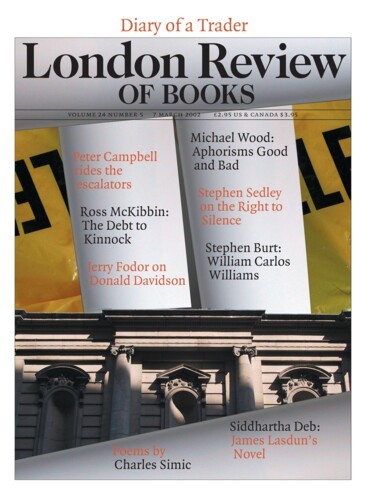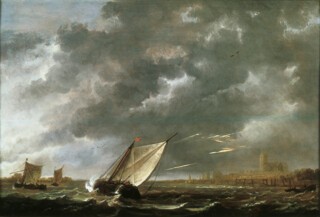Once again the National Gallery visits the Dutch at home. This time not Vermeer and de Hooch’s Delft but Aelbert Cuyp’s Dordrecht: instead of brick courtyards and side-lit rooms where music is played and good housewifery rules, we have boats, meads, cows, horsemen and horsewomen. The people are not so refined – Cuyp’s high finish and urbanity can’t disguise the chubbiness of minor figures. Major ones, despite a taste for fancy dress (a touch of the Hungarian here and the Turkish there), show less than perfect elegance. In French 17th-century pictures one has the impression that the protagonists knew something of the solemn steps of Court ballet, in Italian ones that they had been to a fencing school or learned attitudes from stage-players. Cuyp’s Dutch herdsman sprawls and sleeps without a thought of how he might look to a passing goddess. His master is not quite easy in his clothes.
Cuyp’s mixture of skill and provinciality has its charms, and he did eventually come to find the material for well-managed theatricality in the most pervasive, least specific pictorial element of all: light. In the early pictures there is only the flat, universal illumination you expect from a grey midday sky. Then, from compatriots influenced by their experience of Italy and Italian painting, he learned the trick of making the pale light of the sun as it rises or sets illuminate his scenes through mist or cloud. That kind of light, perfectly true but much rarer than the common light of day, puts yellow highlights on trees, the sails of ships and buildings, makes clouds blush pink and cream, and sets off the gloss of a horse’s flank. Such light, at either end of the day, is the one modern photographers of buildings and landscapes wait for. It may be rare, and more common in the South than the North, but you can experience it once in a while at almost any latitude between the Mediterranean and the Arctic Circle. What had at first to be seen through the eyes of Claude was, in effect, waiting to be noticed by anyone. Repetition wears the charm of these golden moments a bit thin, although the assurance with which the trick is carried off in Cuyp’s pictures, the nice calculation of tone and the sure movements of the brush are always performances worth one’s attention. The English in particular came to love him; in the 18th and 19th centuries collecting Cuyp was so much an English thing that most of his paintings which are not now in this country nevertheless spent much of their lives here. Richard Wilson, Constable and Turner all praised him. Ruskin, too, ranked him highly. It was the pale yellow light that drew them to him, and that they sometimes tried to take from him. In an interesting note on Cuyp’s materials in the catalogue, Marika Spring explains how the fugitive properties of one pigment essential to these effects – yellow lake – have affected the look of the paintings. Fine though they are, we don’t see the pictures as he left them.
Then there are the cows. Horses – even when their anatomy is not quite understood and the foreshortening a little suspect (which is sometimes the case with Cuyp) – are potentially noble animals. Equestrian statuary, from the Parthenon frieze to memorials to 19th-century generals, emphasises their compact, well articulated bodies. Cows, on the other hand, have few laureates. They are angular, and – doubtless because human herdsmen have bred the agility out of them – move clumsily. They seem mere bags of gut and muscle slung on a frame, a beast which shambles if it so much as breaks into a trot. For all their pretty faces (cows can have very pretty faces, although even here Cuyp’s rather dog-faced herds do the species no favours), they have not found many, apart from Cuyp, who have made them regular subject-matter. Sexual dimorphism – also, I would guess, exaggerated by breeding – as extreme as that between bull and cow is another encouragement to discrimination. From Titian to Picasso there have been plenty of bull-paintings.
By staffing so many of his pictures with herds of cattle – some knee-deep in water, some lying down in groups – Cuyp domesticates Claude’s dream-landscapes and turns our eye from a mythical past to what is around us. His sea pieces – apart from a few splendid storm scenes, such as The Maas at Dordrecht in a Storm, with as good a representation of lightning as I know – are quiet, with more ripples and reflections than waves or gun smoke. History painting did not suit him – very amateur theatricals at best.
Send Letters To:
The Editor
London Review of Books,
28 Little Russell Street
London, WC1A 2HN
letters@lrb.co.uk
Please include name, address, and a telephone number.


